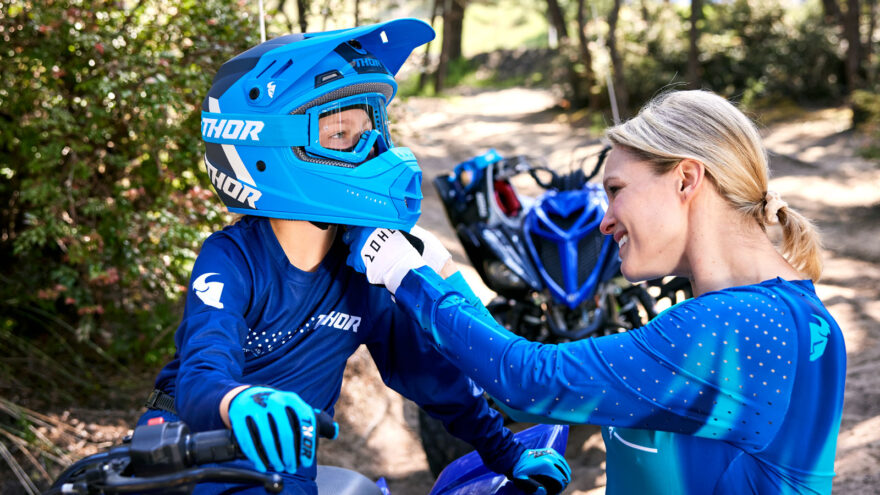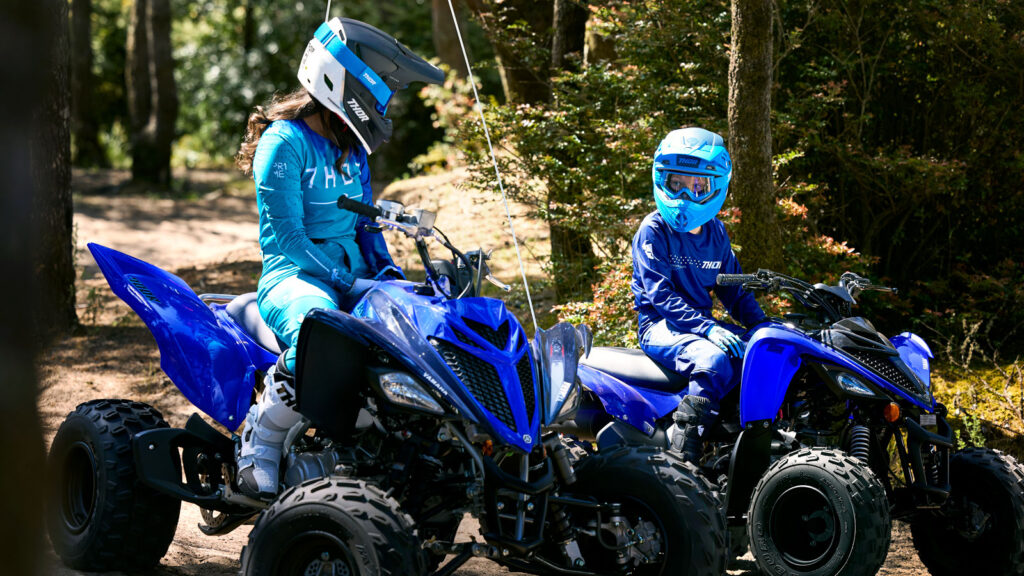
You need to wear a helmet. Let us rephrase that – You NEED to wear a helmet. When you are riding an ATV or riding/driving in a Side-by-Side (SxS), you need to wear a helmet because you need to stay safe. You might as well get used to this idea, too. You need to find the right helmet for your head, and then you need to use it – both your head and your helmet. We want you to stay safe, and one of the best things you can do for your own personal safety when out on your machine is to wear the appropriate safety gear. Not sure how to choose the right helmet, and/or why you need to wear one? We will explain.
Thank you to Yamaha for sponsoring this New Rider series.
Why Wear One?
As someone who has had a couple of bad accidents, I can say with 100% certainty that, had I not been wearing a helmet in these accidents, I would not be alive today. The worst of these accidents happened on a day like any other, on a trail I had ridden many, many times before. I wasn’t using excessive speed and wasn’t fooling around. I was riding along at a normal pace and paying attention to what I was doing. One moment I was enjoying the ride, and the next thing I knew, I was waking up after being knocked unconscious from meeting the ground with my head. I was beat up, bruised, bleeding some from some scratches, and feeling the effects of what was a concussion. It took me some time to get my bearings and I slowly made my way back home before heading off to the doctor.
What happened? It took a while for me to remember things, and then I still had to go back to the spot to examine the area. A washout along the trail caught my front tires and caused them to pop up, which caused me to lose my grip and off I went. From examining the helmet I was wearing, I could tell that I hit pretty hard, and the doctor confirmed that had I not been wearing my helmet, there is zero chance I would have survived the crash. The helmet took the brunt of the impact and the internal foam was crushed, and the outer shell compromised. Better the helmet than my skull, though.
That’s the thing with an accident. No one plans for one. And it is the times when you think you don’t need a helmet because you’re not going to be doing anything dangerous – THAT is when you could have the accident that really does the damage. Many states require helmet use when on an ATV, and you never should ride without one.
Don’t think that being in a SxS with a roll cage means you don’t need a helmet, though. There are a couple of things to consider here. For one, that roll cage does nothing to stop things from coming into the cage. It won’t stop that tree from smacking you in the head should you run into one – and I’ve seen this happen. Plus, you can hit your head on the roll cage in the event of an accident. Again, I have seen this happen. Luckily helmets were in use, but image if they weren’t? Remember, it’s not the stuff you expect to happen that gets you.
Choosing the Right Helmet

There are two basic types of helmet – open face and closed or full face. An open face helmet just covers the back of your head but there is nothing that comes around to enclose your face. Some people really like these types of helmets as they feel more open and relaxed with one. I am not one of those people. I prefer a closed-face helmet, and often wear one that has a chinbar that is vented, with a visor, and I wear goggles with it to protect my eyes. I also have a full-face helmet with a shield that is part of the helmet that protects my eyes. I don’t wear that one as much as it doesn’t allow as much airflow to my mouth.
Comfort is the biggest factor in a helmet. If it isn’t comfortable, you are less likely to wear it. The best advice I can give here is to try on several styles of helmet so you can determine which style is most comfortable to you.
Helmet Fit
A helmet should fit snug, but not pinch and not be too tight. A helmet that is too loose will fit sloppy. You can test this by putting the helmet on and turning your head sharply side-to-side. If your head stops turning but the helmet continues to move some, it is too loose. Along those same lines, if the helmet pinches or is just very uncomfortable to put on, it is too tight. An improperly fitting helmet is dangerous to wear.
Helmets aren’t like shoes for kids, either. You don’t buy one that is too big so your kid can grow into it. That is never the right move. Get one that fits, and if the kid grows out of it, buy a new one. Helmets should make contact with your entire head, and to be completely honest with you, should make you feel right when you wear it. I can’t imagine riding and not wearing one.
Single Use
Never buy a used helmet, regardless if the seller says it was never in an accident. You don’t know for sure if it has been in one or not. Helmets of every price range are single-use. If you have an accident, the helmet is done for. The materials that absorb the impact only are good for one impact, so if you have an accident, get a new helmet. Some helmet manufacturers will do a free inspection for you to see if the helmet is still good, and some dealers will help.
Some of you may think that we are just trying to sell you a helmet. That is not the case, and the manufacturers agree with us. For example, Yamaha wants you to wear a helmet because they want you to enjoy your time on the trails, and for you to keep on enjoying your time on the trails. We all are part of a community, and we want to keep our community safe. Wearing a helmet is one of the best things you can do to be safe and keep on enjoying the sport.
 Your Privacy Choices
Your Privacy Choices
 The
The